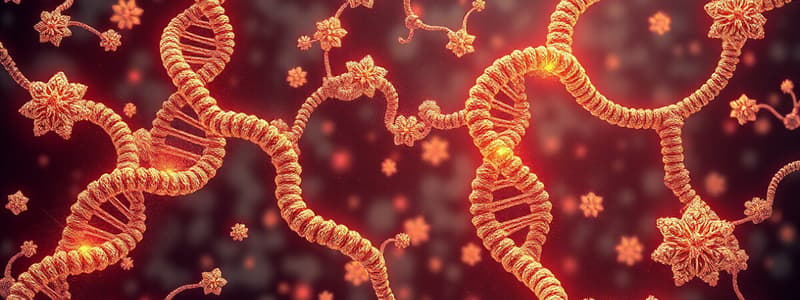Podcast
Questions and Answers
What are the building blocks of nucleic acids?
What are the building blocks of nucleic acids?
- Nucleotides (correct)
- Monosaccharides
- Fatty acids
- Amino acids
Which nitrogen base is found in RNA but not in DNA?
Which nitrogen base is found in RNA but not in DNA?
- Thymine
- Cytosine
- Adenine
- Uracil (correct)
How many chains of nucleotides are present in DNA?
How many chains of nucleotides are present in DNA?
- Four
- Three
- One
- Two (correct)
What is the primary function of RNA?
What is the primary function of RNA?
What sugar is present in DNA?
What sugar is present in DNA?
During protein synthesis, what is the first step that involves transferring genetic information from DNA?
During protein synthesis, what is the first step that involves transferring genetic information from DNA?
Which statement about the structure of RNA is true?
Which statement about the structure of RNA is true?
What type of bond holds the two strands of DNA together?
What type of bond holds the two strands of DNA together?
Flashcards
Nucleic Acid
Nucleic Acid
Large molecules made of carbon, hydrogen, oxygen, nitrogen, and phosphorus.
Nucleotide
Nucleotide
Building blocks of nucleic acids, comprised of a 5-carbon sugar, nitrogen base, and phosphate group.
Classes of Nucleic Acids
Classes of Nucleic Acids
Two main types: Deoxyribonucleic Acid (DNA) and Ribonucleic Acid (RNA).
DNA Function
DNA Function
Signup and view all the flashcards
RNA Function
RNA Function
Signup and view all the flashcards
Transcription
Transcription
Signup and view all the flashcards
Translation
Translation
Signup and view all the flashcards
Comparison of DNA and RNA
Comparison of DNA and RNA
Signup and view all the flashcards
Study Notes
Nucleic Acids
- Nucleic acids are large molecules composed of carbon, hydrogen, oxygen, nitrogen, and phosphorus.
- The building blocks of nucleic acids are nucleotides.
- A nucleotide consists of a 5-carbon sugar (pentose), a nitrogenous base, and a phosphate group.
- Nucleotides link together via dehydration synthesis to form long chains, creating nucleic acids.
Learning Objectives
- Define nucleic acid
- Identify the two classes of nucleic acid
- Compare and contrast DNA and RNA
- Explain protein synthesis
Two Classes of Nucleic Acids
- Deoxyribonucleic acid (DNA)
- Ribonucleic acid (RNA)
Deoxyribonucleic Acid (DNA)
- DNA is the genetic material of cells, controlling cell activities.
- DNA's nucleotides contain deoxyribose sugar and the nitrogenous bases: adenine, thymine, cytosine, and guanine.
- DNA consists of two nucleotide chains joined by hydrogen bonds, forming a double helix.
Ribonucleic Acid (RNA)
- RNA is a single-stranded nucleotide chain.
- RNA's nucleotides contain ribose sugar and the nitrogenous bases: adenine, uracil, cytosine, and guanine.
- RNA's function is protein synthesis within cells.
Comparison of DNA and RNA
| Feature | DNA | RNA |
|---|---|---|
| Sugar | Deoxyribose | Ribose |
| Bases | Adenine, Thymine, Cytosine, Guanine | Adenine, Uracil, Cytosine, Guanine |
| Strands | Double helix | Single strand |
Protein Synthesis
- DNA holds the instructions for protein production within cells.
- Protein synthesis occurs in two steps:
- Transcription
- Translation
Transcription
- DNA separates, and mRNA is created as a complementary copy of a segment of DNA.
- mRNA carries the information from DNA to the cytoplasm where translation takes place.
- mRNA leaves the nucleus.
Translation
- mRNA moves to a ribosome, which is the site of protein synthesis in the cells.
- Transfer RNA (tRNA) molecules bring amino acids to the ribosome.
- The ribosome reads the mRNA's codons, and tRNA delivers the specified amino acids.
- Amino acids bond to form a polypeptide chain, the precursor to a protein.
Studying That Suits You
Use AI to generate personalized quizzes and flashcards to suit your learning preferences.




